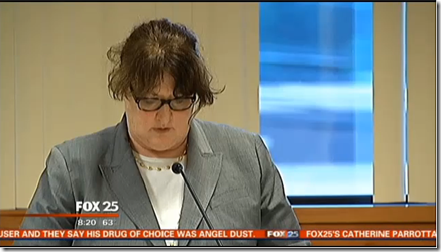Here’s a New One: Don’t Show My Face!
Maureen Sabolinski is the superintendent of schools for the Town of Franklin, Massachusetts.
According to Boston’s FOX 25, a teacher at one of her schools—Franklin High School—”is reportedly under investigation for ‘serious allegations of alleged misconduct.’” Sabolinski told FOX 25 that “the allegations involve a high school teacher, and they came out after a staff member saw something on Twitter.”
Ms. Sabolinski started out okay by making a reasonably good statement about the incident, saying, “It’s a pity and we’ve all felt very sick and devastated. It’s a breach of trust. Parents send their children to us and, if an adult makes a bad choice or blurs the lines, it impacts us all as educators.”
But then things got very, very strange.
The day after releasing that statement, she agreed to give a news conference — but only under one condition: that the television cameras didn’t show her face.
For some reason, FOX 25 agreed to her terms and shot her at an angle from behind. That angle didn’t exactly obscure her features — you can still make out part of her face, her hair, and her back — but it left an unmistakable impression that she was an eccentric person who may have had something to hide.
According to the FOX anchor, Ms. Sabolinski didn’t want to show her face because “the story wasn’t about her.” But that’s the case for corporate and organizational leaders much of the time, and they’re still expected to act as spokespersons for incidents that occur under their watch.
Plus, as the school superintendent, this story was partially about her, insofar as she’s the person who’s expected to handle the situation responsibly while keeping parents informed about her actions. Her job in a crisis is to convey a sense of confidence and competence—and hiding her face didn’t help her send that message successfully.
All Ms. Sabolinski had to do was make a statement that expressed her commitment to learning more about the incident and that pledged to take whatever actions were necessary to ensure the safety of her students. Even the news anchors seemed to grasp the proper crisis management response: get in front of the story and make a short statement that is limited in scope.
Instead, she made a bizarre demand—Don’t show my face!—and earned a merciless five-minute television segment as a result.
A tip o’ the hat to Bill Harlow and Fred Francis of the 15-Seconds blog, who saw this story before I did.
Click here to instantly join our mailing list, and we’ll send you our 21 most essential media training tips and 25 most essential public speaking tips for free.




Maybe she’s just REALLY camera shy. 🙂
But seriously, maybe there is a “legit” reason that she didn’t want to be shown. If that’s the case, they should have chosen a different spokesperson so they could avoid this problem and prevent making a side issue as big a deal as the primary issue. She might have been coerced into doing it and reacted poorly in the heat of the moment.
Just trying to empathize and make sense of it.
Where were the people from the district’s communications department?
Claudia – Good question! It’s possible that she received good communications advice and ignored it, but as you suggest, it’s also possible that her communications people didn’t prepare her adequately. That said, she likely should have known better, with or without comms people. She is a public figure, after all.
Maybe it’s just because I’m viewing this on mobile, but I can’t find the video here. If you have a link saying “to watch the video click here” and you don’t link directly to the video, that’s a big issue. You’re awesome with pr strategy, but perhaps a quick look into web or seo strategy might also be useful now that your blog is so popular.
Jasmine,
You can view that video on your desktop, but mobile can be more problematic for some video formats.
Some video formats won’t play on certain devices. For example, Apple doesn’t make it easy to play Adobe Flash. To get around that problem, I link to YouTube videos whenever possible, since they’re playable on virtually any device. Unfortunately, some videos never make it onto YouTube, so I have to embed a format that doesn’t work as well on some mobile devices. I try to do that as infrequently as possible.
Thank you for visiting the blog!
Best wishes,
Brad